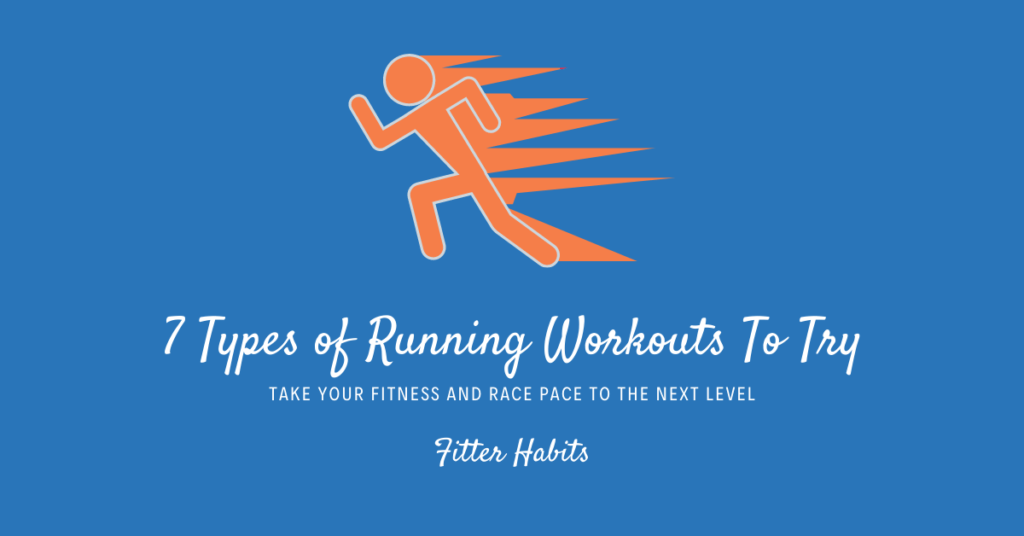These seven types of running workouts will take your fitness and race pace to the next level.
Lots of us run. While it might not seem like all that much fun to do something that wears your legs out, pushes your heart rate through the sky, and makes you gasp for air, we who do it know that’s not what running is all about.
Whether you’re a sprinter or a distance runner, you’re always striving to become a better runner. Improving your natural pace, long-distance running, or any other part of your running requires putting different running types into your training plan. Here are our suggestions.
Contents
7 Types of Running Workouts To Try
1. Fartlek

Fartlek is a Swedish type of training that’s very similar to interval training. However, your intervals vary in speed and length, making them less structured than your standard interval workouts.
Since fartlek runs involve churning your legs until they’re tired, here’s how I would do it: I’d pick an object like a street sign, a light, someone’s mailbox, a specific tree, somewhere up ahead of me. Then I would run as fast as I could to that point. Then I would slow down to a jog until I was ready to pick up my normal pace again.
Fartlek‘s lack of structure gives you more flexibility to play with sprints, jogs, and everything in between. It’s a form of aerobic and anaerobic training. Use them to transition from your base running routine to other, more stringent training types.
2. Tempo Run
When you do tempo runs, you’re running at the hardest pace you can maintain for a set time.
For instance, if your fastest pace is seven minutes per mile and you can hold that pace for two miles, start with jogging until you’re warm. Then run two miles at your seven-minute-per-mile pace, then slow down and jog to cool off. Another option is to run at this pace for a set distance. For example:
- Warm up for two kilometres (2000m)
- Run at this pace for four to six kilometres
- Warm down for one to two kilometres
Tempo runs do two things: They help you increase your top running pace and how long you can hold that pace. They’re also known as threshold runs because they help you push certain limit and run faster over time.
Take care that you don’t put in such a hard effort that you’re gasping for air. You should be out of breath, but still able to speak brokenly.
3. Hill Repeats

I’m a cyclist and a runner, and I used to hate hills with a passion. Know what I learned? Hills become easier if you train on them, which is why you want to have hill repeats in your training plan. They’re sets of runs up hills that are 30 to 45 seconds long in between warm-up and cool-down runs of about two miles each.
Hill repeats build your aerobic power, pain tolerance, strength, and your resistance to high-intensity induced fatigue.
And if you’re like me, you’ll stop hating hills after a while. You might even learn to like them.
4. Base Runs
Your base run is your basic running routine, and serves as the foundation for all your other running. Base runs should constitute most of your weekly training because they improve things like your overall aerobic capacity, endurance, and energy levels.
Base runs are everything to your training plan, so don’t ignore them. In fact, make them the core of your training.
Basically, perform a base run at a comfortable conversational pace. Run between five and ten kilometres or for up to an hour. The ideal is to gradually build aerobic fitness. If this type of run leaves you on the sidelines gasping for air, you’re going too fast!
5. Progression Runs
Progression runs start slow and end fast. They increase your overall stamina and mental strength because they require discipline.
However, they’re also more relaxed than other runs. You start easy and increase your speed periodically, but without straining yourself. If you find yourself breathing too hard or you’re getting too tired too quickly at the start, chances are you need to back off on your speed while running progression runs. That said, it’s fine to finish sweaty and out of breath.
When these are a part of your regular routine, you might even find yourself speeding up at the end of a race or fun run while everyone around you can barely keep going.
6. Interval Training

Unlike fartleks, interval training has a specific structure to it. You alternate between either long or short bursts of intensity with jogging, easy running, or walking. Each interval is roughly the same length, so if you run hard for two minutes, you’ll jog for two minutes.
I’m not going to lie. I find interval runs difficult because the point of it is to push myself until I’m gasping for air at the end of each sprint. This particular type of run hurts. The reason I do them is because they build up my speed and energy economy and resistance to fatigue. But they are hard workouts.
You’ll become a better runner and develop better running economy overall if you integrate intervals into your weekly training.
7. Recovery Runs
These are also known as easy runs. Done at a very easy pace, your recovery run is short and takes place the day after workouts requiring hard effort, for example interval training, threshold runs or other speed workouts.
They’re called recovery runs for a reason, and you should take advantage of them, particularly after hard training days. They help your body recover naturally and combat muscle soreness. Ultimately, they’ll reduce your recovery time between big sessions.
Be careful not to force a shortened recovery time though. You’re more likely to hurt yourself if you stack back-to-back hard sessions without a recovery run.
The Final Word On Types of Running Workouts
We runners have all long since learned that a new pair of running shoes isn’t the secret to becoming a better runner. To address common running problems, include several of these types of running workouts in your next training plan. Or look for one that features them.
Each one of these focuses on one or more specific issues unique to runners, including high-intensity runs, marathons and half-marathons, and sprinting, as well as improving internal processes involving aerobic power and anaerobic thresholds.
Of course, you need to build all of this around your base run, including your recovery run. But developing a routine with all of these in mind will help improve your running by a lot.



